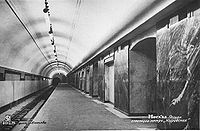
Nikolai Kolli
Encyclopedia

Born in Moscow, Kolli studied at the Moscow School of Painting, Sculpture and Architecture
Moscow School of Painting, Sculpture and Architecture
The Moscow School of Painting, Sculpture and Architecture was one of the largest educational institutions in Russia. The school was formed by the 1865 merger of a private art college, established in Moscow in 1832, and the Palace School of Architecture, established in 1749 by Dmitry Ukhtomsky. By...
and then at Vkhutemas
VKhUTEMAS
Vkhutemas ) was the Russian state art and technical school founded in 1920 in Moscow, replacing the Moscow Svomas. The workshops were established by a decree from Vladimir Lenin with the intentions, in the words of the Soviet government, "to prepare master artists of the highest qualifications for...
. He first came to attention with a 1918 proposal for a monument celebrating the victory of the Red Army over General Krasnov
Pyotr Krasnov
Pyotr Nikolayevich Krasnov , 1869 – January 17, 1947), sometimes referred to in English as Peter Krasnov, was Lieutenant General of the Russian army when the revolution broke out in 1917, and one of the leaders of the counterrevolutionary White movement afterward.- Russian Army :Pyotr Krasnov...
, in the form of a red wedge cleaving a block of white stone, an image that El Lissitzky
El Lissitzky
, better known as El Lissitzky , was a Russian artist, designer, photographer, typographer, polemicist and architect. He was an important figure of the Russian avant garde, helping develop suprematism with his mentor, Kazimir Malevich, and designing numerous exhibition displays and propaganda works...
subsequently appropriated and refined
Beat the Whites with the Red Wedge
Beat the Whites with the Red Wedge is a lithographic Soviet propaganda poster by artist Lazar Markovich Lissitzky better known as El Lissitzky...
.
Kolli studied under Ivan Zholtovsky as one of his "Twelve Disciples" and became a member of both the Soviet OSA Group
OSA Group
The OSA Group was an architectural association in the Soviet Union, which was active from 1925 to 1930 and considered the first group of constructivist architects...
(Union of Contemporary Architects) and a delegate to the international CIAM
Congrès International d'Architecture Moderne
The Congrès internationaux d'architecture moderne – CIAM was an organization founded in 1928 and disbanded in 1959, responsible for a series of events and congresses arranged around the world by the most prominent architects of the time, with the objective of spreading the principles of the Modern...
architectural group in the late 1920s. From 1928 through 1932 he lived part time in Paris, assisting Le Corbusier
Le Corbusier
Charles-Édouard Jeanneret, better known as Le Corbusier , was a Swiss-born French architect, designer, urbanist, writer and painter, famous for being one of the pioneers of what now is called modern architecture. He was born in Switzerland and became a French citizen in 1930...
in the architect's only built work in Moscow, the Tsentrosoyuz building
Tsentrosoyuz building
The Tsentrosoyuz Building or Centrosoyuz Building is a government structure in Moscow, Russia, constructed in 1933 by Le Corbusier and Nikolai Kolli. Centrosoyuz refers to a Soviet bureaucracy, the Central Union of Consumer Cooperatives. The building included office space for 3,500 personnel, as...
.
From 1935 to 1951 he headed the Moscow branch of the Soviet Union of Architects. He's buried in the Vvedenskoye Cemetery.
Work
- Dnieper Hydroelectric StationDnieper Hydroelectric StationThe Dnieper Hydroelectric Station is the largest hydroelectric power station on the Dnieper River, placed in Zaporizhia, Ukraine.- Early Plans :In the lower current of the Dnieper River there were almost 100 km long part of the river filled with rapids...
, on the Dnieper RiverDnieper RiverThe Dnieper River is one of the major rivers of Europe that flows from Russia, through Belarus and Ukraine, to the Black Sea.The total length is and has a drainage basin of .The river is noted for its dams and hydroelectric stations...
in Zaporizhzhia, 1927-1932, with Viktor Aleksandrovic VesninViktor Aleksandrovic VesninViktor Aleksandrovich Vesnin , was a Russian Soviet architect. His early works follow the canon of Neoclassicist Revival; in 1920's, he and his brothers Leonid and Alexander emerged as leaders of Constructivist architecture, the Vesnin brothers...
and others - Tsentrosoyuz buildingTsentrosoyuz buildingThe Tsentrosoyuz Building or Centrosoyuz Building is a government structure in Moscow, Russia, constructed in 1933 by Le Corbusier and Nikolai Kolli. Centrosoyuz refers to a Soviet bureaucracy, the Central Union of Consumer Cooperatives. The building included office space for 3,500 personnel, as...
, Moscow, 1933, with Le CorbusierLe CorbusierCharles-Édouard Jeanneret, better known as Le Corbusier , was a Swiss-born French architect, designer, urbanist, writer and painter, famous for being one of the pioneers of what now is called modern architecture. He was born in Switzerland and became a French citizen in 1930... - Chistye Prudy station of the Moscow MetroMoscow MetroThe Moscow Metro is a rapid transit system serving Moscow and the neighbouring town of Krasnogorsk. Opened in 1935 with one line and 13 stations, it was the first underground railway system in the Soviet Union. As of 2011, the Moscow Metro has 182 stations and its route length is . The system is...
, 1935 - North Pavilion for the Park Kultury station of the Moscow Metro, 1935, with S.G. Andrievsky
- Paveletskaya station of the Moscow MetroMoscow MetroThe Moscow Metro is a rapid transit system serving Moscow and the neighbouring town of Krasnogorsk. Opened in 1935 with one line and 13 stations, it was the first underground railway system in the Soviet Union. As of 2011, the Moscow Metro has 182 stations and its route length is . The system is...
, 1950, with I. Kasetl - Buried

